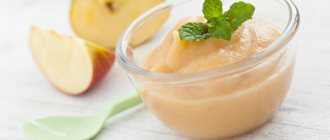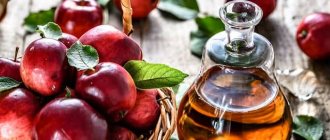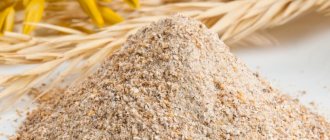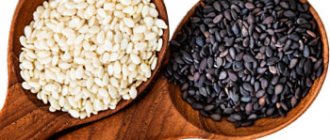Benefits, harms and calorie content of apple cider
Photo: Depositphotos.com. Author: belchonock.
In the Middle Ages, apple cider gained popularity and was enjoyed with pleasure throughout Europe. And in Tsarist Russia, it even supplanted champagne, gaining the status of secular alcohol.
Production technology
Apple cider is a low-alcohol drink produced through natural fermentation. Yeast is not used for this.
Apples are peeled from stems and rotten parts, then passed through a meat grinder or industrial grinder. Since the aromatic and taste qualities of the future cider largely depend on the skin, they strive to preserve it.
After preliminary preparation, the fruits are pressed using a membrane press and subjected to fermentation with further ripening. The entire process usually takes from six months to a year.
In addition to the fruit pulp along with the juice squeezed out of the fruit, various additives in the form of sugar and spices are used to make cider.
Calorie content and composition
The calorie content is low and comparable to many diet drinks. The exact figure varies depending on the sugar content and ranges from 47 to 119 kcal per 100 g.
There is practically no fat (no more than 0.11%). But for people who are prone to excess weight, frequent consumption of sweet apple cider is not recommended.
How is it useful?
The drink contains phenolic compounds (tannins), which normalize the functioning of the digestive system.
The drink, prepared according to a traditional recipe, contains a number of compounds, each of which has health benefits:
Variations and Additions
Photo: Depositphotos.com. Author: funix.
For example, residents of Southern France love apple cider with Provençal herbs, which give the drink a special, refined taste, and fortified cider (up to 11 degrees). And the Scots add dried berries along with leaves to cider.
Apple Cider Snack
The foamy drink goes well with sea or river fish, as well as a variety of seafood. There's nothing better than an appetizer of grilled oysters and shrimp. Meat delicacies are also perfect as a snack - low-fat shish kebab, dry-cured jamon, ham, dry sausage or classic duck stew.
https://www.youtube.com/watch?v=b08SaueVjas
Apple drink goes well with various goat cheeses, mascarpone, feta cheese and so on. Both salty and sweet varieties of cheese are perfect.
An interesting combination of taste qualities is obtained when eating a drink with chocolate or candies filled with dried fruits. Cakes, sweet pies and a variety of desserts are also good options. Of course, apple-pear alcohol goes perfectly with fruit or fruit salads.
Apple cider #8212; benefits and harm to health
Meanwhile, proper apple cider is made without any additives, from the purest juice of sour fruits. This drink is recognized as healing. Let's figure it out together.
The benefits of cider
Why is apple cider so beneficial? For example, for the digestive system, the positive effect is:
- Absorptions. Pectins, entering the intestines, cleanse it of fats and unfavorable acids.
- Normalization. The composition of apple cider allows it to be used to normalize metabolism in the right direction. Moreover, it is very soft and correct, without sudden jumps.
- Suppression. These same pectins remarkably suppress the growth of pathogenic microflora. This helps the development of friendly microorganisms.
And these extremely useful pectins help the body cope with the consequences of radiation damage. This consists of accelerated removal of heavy metals and radioactive substances.
Cider for immunity
A properly produced drink retains almost all the vitamins and microelements found in the raw material. For example, apple juice contains a large amount of vitamin C. This means that cider also contains a lot of it.
For the heart and blood vessels - cider again
Like any other alcohol, apple cider dilates blood vessels. This feature can be used for good. Of course, if you drink the drink in moderation. Just like medicine.
But that is not all. The enzymes formed in cider during fermentation also have a very beneficial effect on the entire cardiovascular system. They:
- strengthen the walls of blood vessels
- make them elastic
- reduce accumulations of bad cholesterol
- remove atherosclerotic plaques
Therefore, some doctors recommend that people with hypertension drink 120 ml of apple cider at night.
Advice. Don't overuse cider. After all, it is alcohol after all. And don’t even think about self-medicating! Such permissiveness threatens hypertensive patients with great disaster. Always seek the advice of your physician or other qualified health professional.
Cider for slimness
In some diets you can find an interesting recommendation. Before your main meal (usually lunch), drink 200 ml of apple cider. This means a low-alcohol drink, no more than 2% alcohol.
It would seem, how so? After all, cider greatly increases your appetite. What positive effect will such an insidious drink have? It turns out that it is very favorable for those who watch their figure.
The harm of apple cider
Please remember that the drink contains alcohol. Albeit in small quantities. Therefore, there are several categories of people for whom apple cider, instead of benefit, can cause significant harm. These include:
- children under 18 years old
- pregnant women and nursing mothers
- elderly over 60
It is quite natural that any type of alcohol is contraindicated for people whose work involves increased concentration. We will not list the entire list of professions, there is not enough space. Those who cannot drink alcohol know this themselves.
This means that apple cider is highly not recommended for those who suffer from:
- hepatitis A
- peptic ulcer of the stomach and duodenum
- diseases of the genitourinary system
- pyelonephritis
In short, for those people who know their diagnosis, it is advisable to find other ways to benefit. For those who do not yet know about the troubles of their body, it is better not to take risks either. Otherwise they’ll bite into the pop and consume it in deciliters.
Advice. If you have never tried real apple cider in your life, then don’t rush to get pumped up right away. Although there will definitely be temptation. First try just a little, half a glass. Listen to your body. And only if there are no unpleasant sensations, you can taste this unique drink to your heart's content.
How to make homemade apple cider
Making apple cider with your own hands is not at all difficult, but you can be one hundred percent sure of the beneficial properties of the product. You just need to find suitable fruits, and the easiest way to do this is in abandoned orchards or even in the forest where wild apple trees grow. Not only do you need not just any apples to make cider, but they also need to be kept for at least 2-4 days in a warm room.
In the future, you can use two methods of making cider: from fruits with sugar and from apple juice without added sugar.
First way
For this recipe you will need:
- 10 kg of apples, peeled from seeds and branches;
- 1.5 kg of sugar.
The cooking process consists of the following steps:
- The apples are sorted, removing all spoiled areas and cutting out all the tails and seeds.
- Then they are passed through a meat grinder and supplemented with sugar, stirred thoroughly.
- Fill clean and dry containers with the grated apple mixture to about 2/3 of the original volume. You can use three-liter jars.
- The opening of each jar is covered with gauze and placed for 3-4 days in a warm place with a temperature of + 23 ° C to + 25 ° C, without light. The contents of the jars are mixed every day.
- When the apple mass has actively fermented (foam and a characteristic smell appear), the juice is squeezed out of the mass and poured into dry jars in the same volume.
- A rubber glove with a hole in one of the fingers is put on each can or a water seal is installed. This is necessary in order to limit the access of oxygen to the apple juice, otherwise it may simply turn sour.
- The jars are placed in a dark and warm place for a period of 20 to 65 days. Fermentation can be considered complete if the glove falls off and a thick sediment falls to the bottom.
- The cider is carefully drained from the cans without disturbing the sediment. This can be done through a special flexible tube, lowering one end below the level of the jar.
- It is advisable to further filter the drink and bottle it, capping it tightly.
- Next, apple cider must ripen for at least 3 months in cool conditions (at 6 ° C to 11 ° C).
- The strength of the resulting drink is 7-12 °C.
Second way
With this manufacturing method, you don’t need anything other than the apples themselves. Therefore, you can get a product that has the most beneficial properties. The recipe is closest to the classic one used in European countries.
- The prepared fruits are passed through a juicer, after which the juice is left to sit for about a day at room conditions.
- After settling, the liquid is drained without affecting the sediment at the bottom. Distribute into dry and clean jars, putting a glove on each of them.
- The juice is also left to stand in a warm place without light for about 3-5 weeks.
- When fermentation is over, the cider is drained from the residue in the same way and kept in a dark room again, but at a temperature of + 6 ° C to + 11 ° C for about 3-4 months.
- Then it is filtered again, bottled, sealed and stored in the refrigerator.
- The strength of such a drink ranges from 4 °C to 8 °C.
Another option for making apple cider using a combined recipe is shown in the video below.
What to do to make cider carbonated
It’s easy to make real carbonated apple cider at home. To do this, at the stage of completion of fermentation, after filtering, it is poured into absolutely clean and dry bottles (plastic or glass). At the bottom of each bottle, before pouring the cider, add 10 g of sugar (a heaping teaspoon) per 1 liter of liquid.
The drink bottle should have 6-8 cm of free space at the top. The containers are hermetically sealed with lids and placed for two weeks in a warm room without light.
Sugar causes repeated fermentation, releasing carbon dioxide. Therefore, the gas pressure should be checked daily to release excess gas. Otherwise, it may be difficult to preserve the bottle. After two weeks, bottles of carbonated apple cider are transferred to the refrigerator or cellar for storage.
Benefits, harms and calorie content of apple cider
Photo: Depositphotos.com. Author: belchonock.
In the Middle Ages, apple cider gained popularity and was enjoyed with pleasure throughout Europe. And in Tsarist Russia, it even supplanted champagne, gaining the status of secular alcohol.
Production technology
Apple cider is a low-alcohol drink produced through natural fermentation. Yeast is not used for this.
Apples are peeled from stems and rotten parts, then passed through a meat grinder or industrial grinder. Since the aromatic and taste qualities of the future cider largely depend on the skin, they strive to preserve it.
After preliminary preparation, the fruits are pressed using a membrane press and subjected to fermentation with further ripening. The entire process usually takes from six months to a year.
In addition to the fruit pulp along with the juice squeezed out of the fruit, various additives in the form of sugar and spices are used to make cider.
Calorie content and composition
The calorie content is low and comparable to many diet drinks. The exact figure varies depending on the sugar content and ranges from 47 to 119 kcal per 100 g.
There is practically no fat (no more than 0.11%). But for people who are prone to excess weight, frequent consumption of sweet apple cider is not recommended.
How is it useful?
The drink contains phenolic compounds (tannins), which normalize the functioning of the digestive system.
The drink, prepared according to a traditional recipe, contains a number of compounds, each of which has health benefits:
Variations and Additions
Photo: Depositphotos.com. Author: funix.
For example, residents of Southern France love apple cider with Provençal herbs, which give the drink a special, refined taste, and fortified cider (up to 11 degrees). And the Scots add dried berries along with leaves to cider.
We also recommend reading: Cahors and its beneficial properties.
Contraindications and possible harm
- Apple cider is an alcoholic drink, so it should not be consumed by children, pregnant or lactating women.
- It has high acidity, which means it is contraindicated for problems with the gastrointestinal tract (especially peptic ulcers and gastritis).
- Diabetics are also advised to refrain from drinking carbonated apple wine, so as not to provoke a sharp rise in blood sugar levels.
- It is harmful for people with illnesses such as cholecystitis and pancreatitis to drink cider (due to the high concentration of fruit acids).
How to drink correctly?
Can be used to create cocktails. But cider does not go well with some alcoholic drinks.
Cider or beer - which is healthier?
The benefits of apple cider come from polyphenols, plant-based antioxidants that protect human body cells from oxidative stress. But when scientists from the University of Glasgow compared two types of cider with the same production method, a variation in the concentration of polyphenols was discovered. The reason is probably due to the use of different varieties of apples.
Another advantage of beer is its low carbohydrate content, since cider is much sweeter (it contains from 15 g to 23 g of sugar, depending on the apples used).
Any of these drinks can have health benefits, but only if consumed in moderation. Which one is better - choose for yourself.
Next of kin
This drink in the French version has a strength of no more than 2 degrees, while in the English version it is up to 8 degrees.
Perry has its own beneficial properties, which we will talk about next time.
In the Middle Ages, apple cider gained popularity and was enjoyed with pleasure throughout Europe. And in Tsarist Russia, it even supplanted champagne, gaining the status of secular alcohol.
Photo: Depositphotos.com. Author: belchonock.
Cider composition, strength and calorie content
The properties of the drink are a consequence of the characteristics of cider production. Only at first glance, the cooking technology is very simple:
- picking apples and ripening them for one and a half to two weeks;
- selection and cleaning of apples from seeds and cores;
- apple chopping and pressing;
- adding water to the pulp and squeezing again;
- the resulting liquids were combined and settled;
- filtered the juice and poured it into tanks for fermentation;
- at low temperatures, fermentation lasted from 1.5 to 2 months;
- fermented cider wine materials are aged for 10-12 months;
- then it is clarified and blended. pasteurized and bottled.
How many calories are in cider depends on the source material and whether sugar is added to it. The sweeter the apples, the higher the calorie content. And how many degrees there are in cider is affected by the sugar content of the raw material and the duration of the fermentation process.
Since ancient times, little has changed in cooking technology, but the equipment used and technical equipment have changed a lot. Now at its production, varieties of apples, pears and quinces are strictly selected, specifically intended for the production of this drink.
To speed up the fermentation process, pure yeast cultures are used, as well as fermentation of juices with pectolytic and amylolytic drugs. If necessary, sugar is added, and the finished product is saturated with carbon dioxide for effervescence. In production, laboratory tests of the prepared product are constantly carried out, the level of acidity, the level of saturation with pectins and enzymes are determined.
Apple cider includes tannins and pectin, carbohydrates, trace elements, polyhydric alcohols, as well as acetic, citric and malic acid. Let's take a closer look (per 100 ml):
- water – 99.6-99.7 g;
- fat – 0.02 g;
- proteins – 0.06 g;
- carbohydrates – 12.2 g;
- ash – 0.1 g.
Vitamins:
- Ascorbic acid (vitamin C) – 24-25 g.
Macronutrients:
- sodium – 14 mg;
- calcium – 11 mg;
- phosphorus – 12 mg;
- magnesium – 1 mg.
Microelements:
- copper – 0.15 mg;
- iron – 0.03 mg;
- zinc – 0.3 mg.
The calorie content of cider is low, it is comparable to many diet drinks. The most accurate indicator directly depends on the amount of sugar used and the natural sweetness of the apples; it varies from 46 to 118 kcal per 100 ml.
Why is it useful?
The drink contains phenolic compounds (tannins), which normalize the functioning of the digestive system.
The drink, prepared according to a traditional recipe, contains a number of compounds, each of which has health benefits:
- Vitamin C is present in naturally fermented apple cider in large quantities. Therefore, moderate consumption of the drink during the cold season can increase the body's immunity and resistance to seasonal diseases.
- Pectins (part of the group of polysaccharides) in carbonated apple wine, entering the gastrointestinal tract, work as absorbents of bile acids and fats, normalize microflora, promoting the proliferation of friendly bacteria in the intestines. In addition, pectins remove heavy metals and radioactive substances.
- Vitamins of groups A, B and microelements (potassium, calcium, phosphorus, sodium, fluorine, zinc, iron and iodine) are responsible for a number of vital processes in the human body. They improve metabolism, provide good health and mood.
Contraindications
The nutritional value
Let's look at the nutritional value of a product as a percentage of the recommended daily requirement (RDI) of an average adult.
Composition of the product weighing 100 ml:
Components
| Ratio in grams | Percentage in relation to RSP | |
| Squirrels | 0,06 | |
| Saturated fats | 0,02 | |
| Polyunsaturated fats | 0,035 | |
| Monounsaturated fats | 0,005 | |
| Carbohydrates | 12,24 | 4 |
Variations and Additions
Photo: Depositphotos.com. Author: funix.
Initially, the recipe for apple cider with a pronounced taste of ripe apples did not contain any additives, but over the course of its rich history it managed to acquire a lot of variations. In various countries and regions, they practice producing an alcoholic drink using classical technology, but with the addition of original ingredients.
For example, residents of Southern France love apple cider with Provençal herbs, which give the drink a special, refined taste, and fortified cider (up to 11 degrees). And the Scots add dried berries along with leaves to cider.
Contraindications and possible harm
- Apple cider is an alcoholic drink, so it should not be consumed by children, pregnant or lactating women.
- It has high acidity, which means it is contraindicated for problems with the gastrointestinal tract (especially peptic ulcers and gastritis).
- Diabetics are also advised to refrain from drinking carbonated apple wine, so as not to provoke a sharp rise in blood sugar levels.
- It is harmful for people with illnesses such as cholecystitis and pancreatitis to drink cider (due to the high concentration of fruit acids).
How to Drink and Serve Apple Cider
Apple cider tastes best when chilled. There are two ways to serve this drink:
- It is initially cooled to a temperature of + 12 °C to + 14 °C. And from a height of at least 1 m, the bottle is poured into six glasses. When a strong jet touches the glass of a glass, foam will form. Since it disappears quickly, the cider should be consumed fairly quickly.
- Otherwise, the cider does not require pre-chilling. And you just need to put ice in glasses and top up the drink. In this case, you can drink even in small sips.
There may be sediment at the bottom, which is not necessary to finish, but it indicates the natural origin of the product.
Cider goes well with fish or meat dishes, but is ideal served with cheese dishes and fresh fruit.
Cider or beer?
With similar caloric content, the composition of beer differs from apple cider and includes yeast, hops, barley and other grains. In particular, beer contains more protein and B vitamins than carbonated apple wine, as well as a good dose of potassium.
The benefits of apple cider come from polyphenols, plant-based antioxidants that protect human body cells from oxidative stress. But when scientists from the University of Glasgow compared two types of cider with the same production method, a variation in the concentration of polyphenols was discovered. The reason is probably due to the use of different varieties of apples.
However, the beer is significantly behind its competitor in this regard. The reason lies in the fact that during the brewing process, cloudy sediment containing polyphenols from hops and malt is removed. And yet the drink does have certain antioxidant properties. No wonder Italian experts found that its moderate consumption reduces the risk of cardiovascular diseases by 31%.
Another advantage of beer is its low carbohydrate content, since cider is much sweeter (it contains from 15 g to 23 g of sugar, depending on the apples used).
Any of these drinks can have health benefits, but only if consumed in moderation. Which one is better - choose for yourself.











